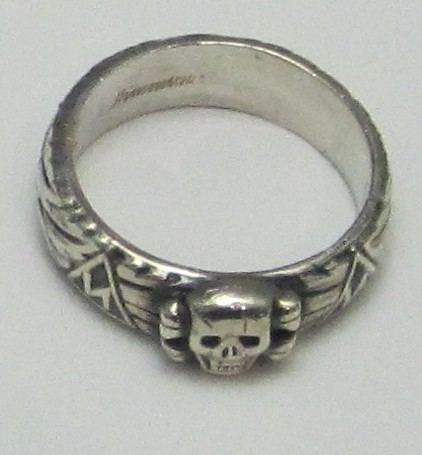 | ||
The SS-Ehrenring ("SS Honour Ring"), unofficially called Totenkopfring ("Death's Head Ring"), was an award of Heinrich Himmler's Schutzstaffel (SS). It was not a state decoration, but rather a personal gift bestowed by Himmler. The SS Honor Sword and SS Honor Dagger were similar awards.
Contents
Award
The ring was initially presented to senior officers of the Old Guard (of which there were fewer than 5,000). By 1939, it was available to officers with 3 years service in the SS. Each ring had the recipient's name, the award date, and Himmler's signature engraved on the interior. The ring came with a standard letter from Himmler and citation. It was to only be worn on the left hand, on the "ring finger". If an SS member was dismissed or retired from the service, his ring had to be returned.
The name of the recipient and the conferment date was added on the letter. In the letter, Himmler wrote that the ring was a "reminder at all times to be willing to risk the life of our selves for the life of the whole".
It became a highly sought-after award, one which could not be bought or sold. Some SS and police members had local jewelers make unofficial versions to wear. In 1938 Himmler ordered the return of all rings of dead SS-men and officers to be stored in a chest in Wewelsburg Castle. This was to be a memorial to symbolize the ongoing membership of the deceased in the SS-order. In October 1944, Himmler ordered that further manufacture and awards of the ring were to be halted. Himmler then ordered that all the remaining rings, approximately 11,500, blast-sealed inside a hill near Wewelsburg. By January 1945, 64% of the 14,500 rings made had been returned to Himmler after the deaths of the "holders". In addition, 10% had been lost on the battlefield and 26% were either kept by the holder or their whereabouts were unknown.
Design
The design of the ring reflects Himmler's interest in Germanic mysticism and includes the Totenkopf symbol and Armanen runes.
The ring is wreathed with oak leaves.
